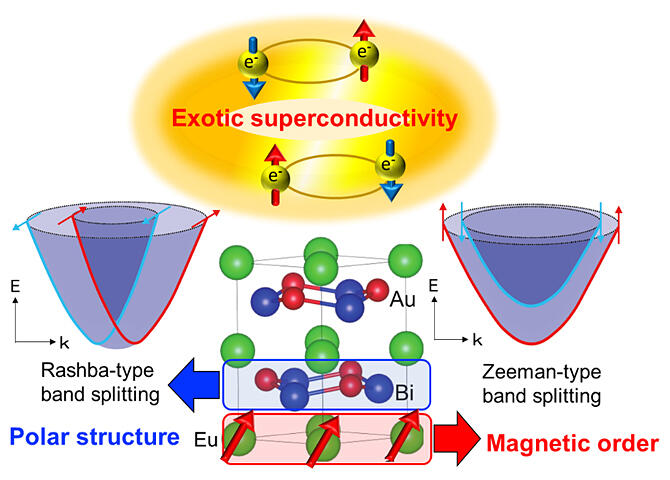A research group led by Assistant Professor Hidefumi Takahashi and Professor Shintaro Ishiwata of the Graduate School of Engineering Science at Osaka University, has successfully synthesized a single crystal of the topological semimetal EuAuBi, which has a layered structure consisting of an Eu (europium) layer responsible for magnetism and an Au‐Bi (gold‐bismuth) layer responsible for electron conduction. The researchers were able to obtain an antiferromagnetic transition at 4 K and a superconducting transition at 2.4 K.
Superconductors are one of the components that support state‐of‐the‐art industrial technologies, such as magnetic resonance imaging (MRI) medical devices and the superconducting maglev train. The development of new superconductors is critical not only for such industrial applications but also from the perspective of basic research, and the search for special superconducting states beyond the standard BCS theory, is underway.

Provided by Osaka University
Typical superconductivity was thought to be incompatible with properties such as magnetism and polarity, but recently materials have been found that exhibit new types of superconducting states where these properties are exploited. The research group discovered that the compound EuAuBi, which is both magnetic and polar, exhibits superconductivity, and through cryogenic property measurements and theoretical calculations, they observed a superconducting transition at 2.4 K, where a special superconducting state is achieved.
The polar structure of the material is achieved by the alternating displacement of the Au and Bi ions forming a honeycomb lattice in the interplane direction, making it an unusual system that exhibits magnetic ordering and superconductivity despite its polar structure. It not only contains Eu, which has a very strong magnetism, but also has a polar structure composed of heavy elements such as bismuth and gold. It is expected that these act on the conduction electrons to form a new type of superconductivity that exhibits special stability against external fields such as magnetic fields.
The results of this research were published in the January issue of the Journal of the Physical Society of Japan, an English language journal published by the Physical Society of Japan.
"The superconducting transition temperature of this compound is as low as 2.4 K (about ‐271 ℃), which hinders further basic research and the development of industrial applications," explained Takahashi. "Therefore, in the future we would like to improve the superconducting properties by replacing some of the chemical composition with other elements."
Journal Information
Publication: Journal of the Physical Society of Japan
Title: Superconductivity in a Magnetic Rashba Semimetal EuAuBi
DOI: 10.7566/JPSJ.92.013701
This article has been translated by JST with permission from The Science News Ltd. (https://sci-news.co.jp/). Unauthorized reproduction of the article and photographs is prohibited.




